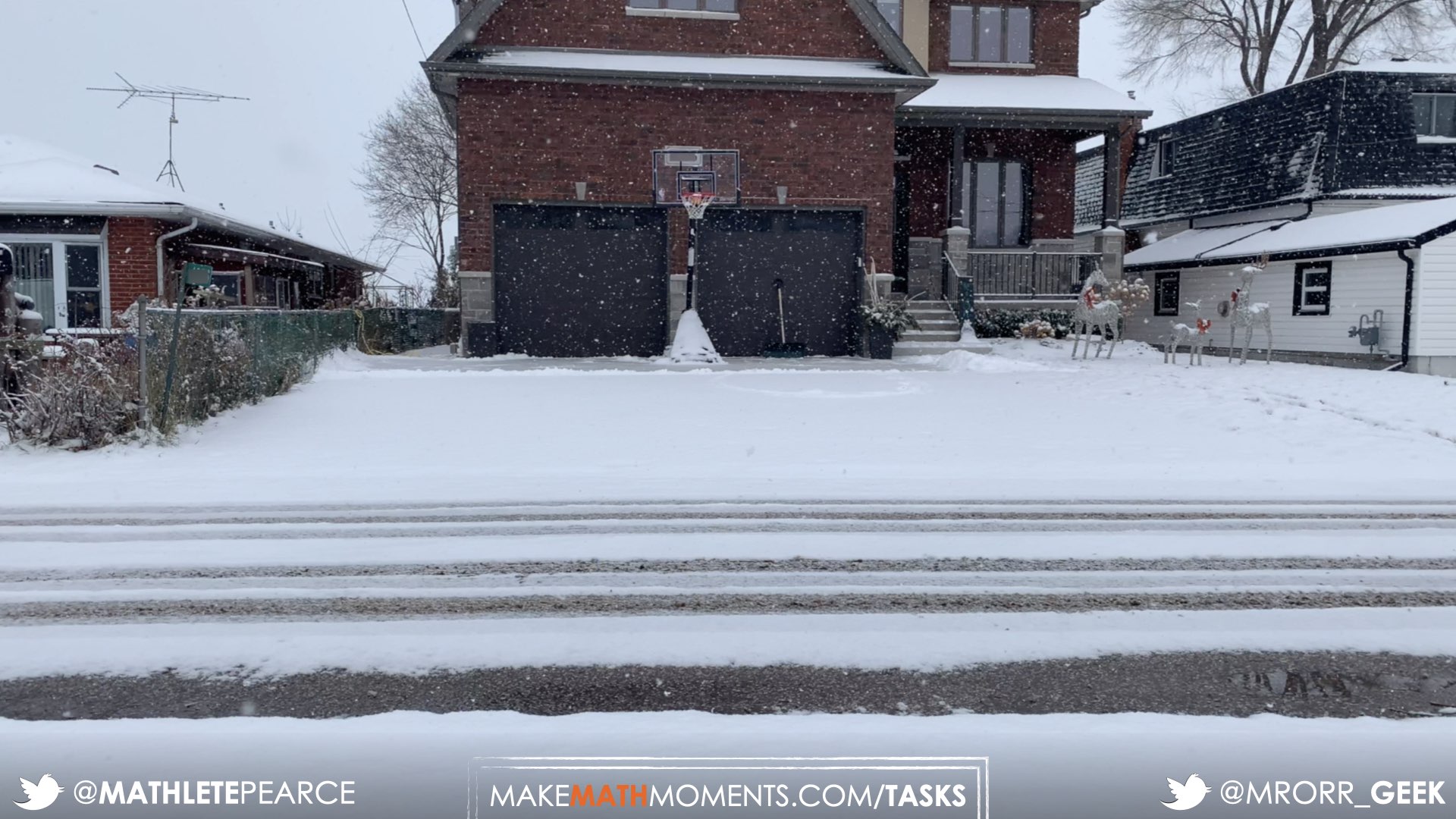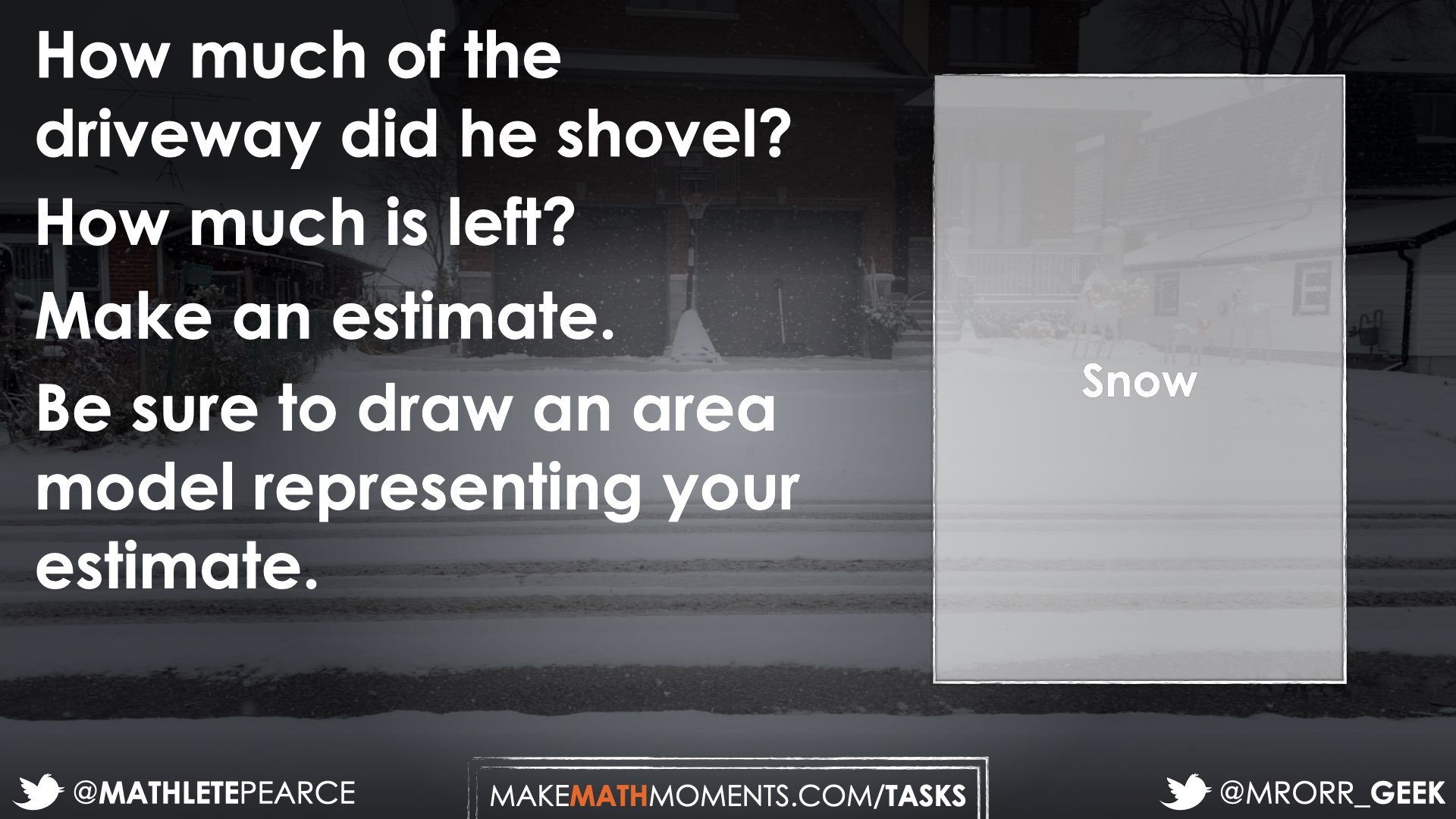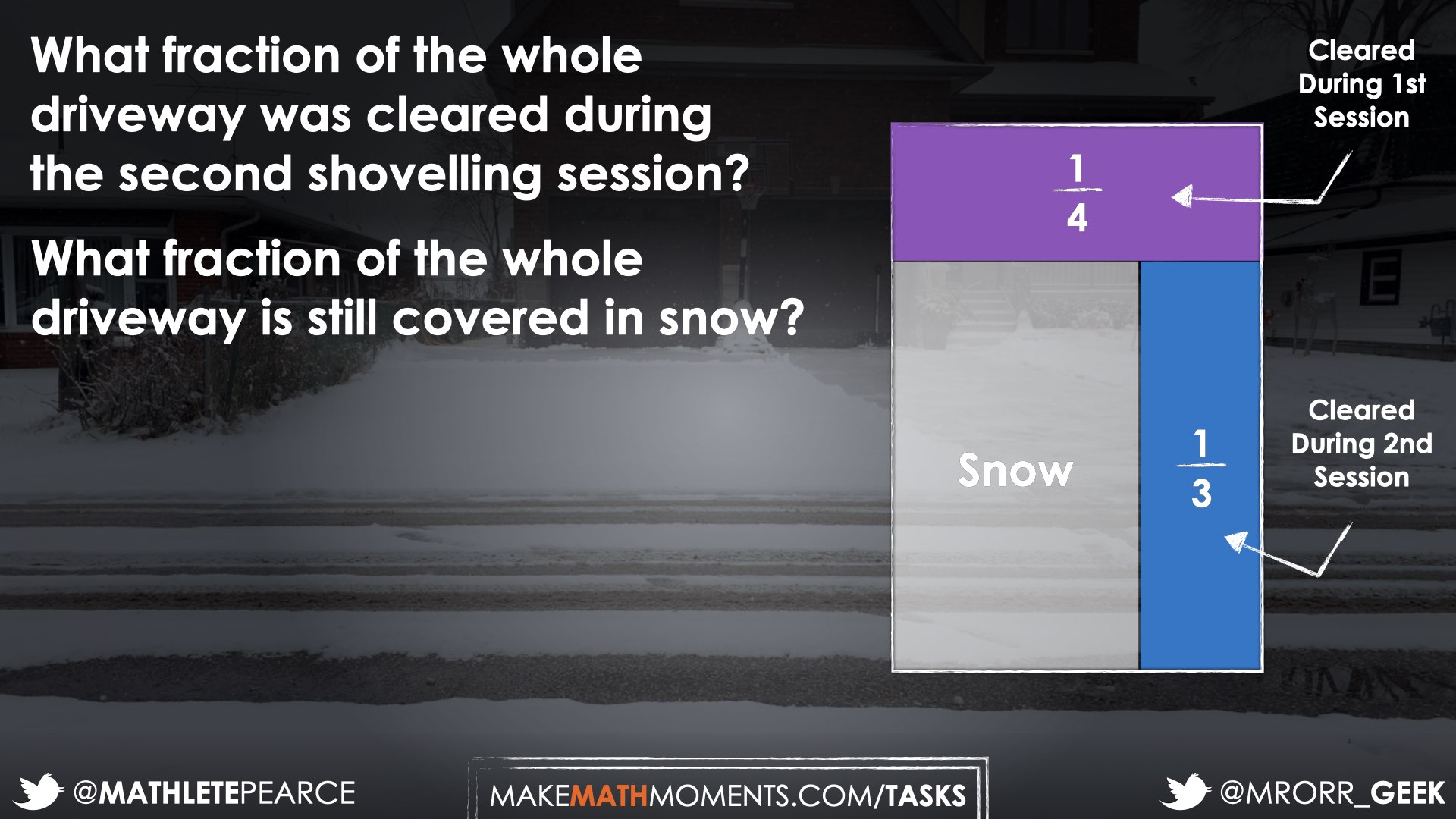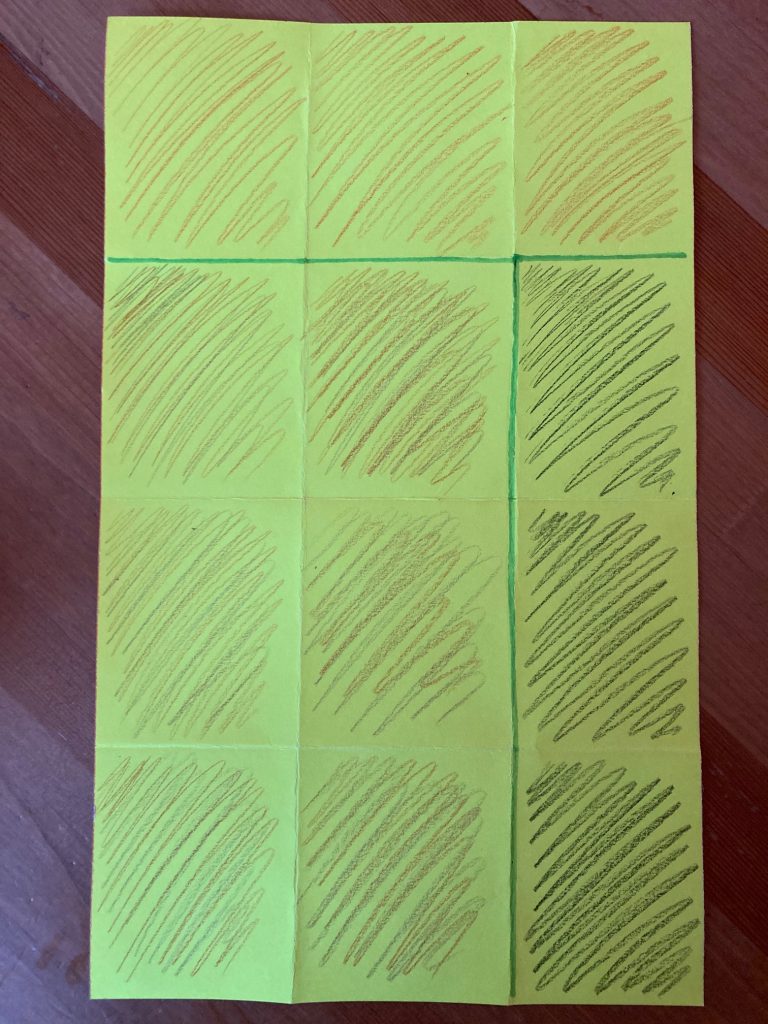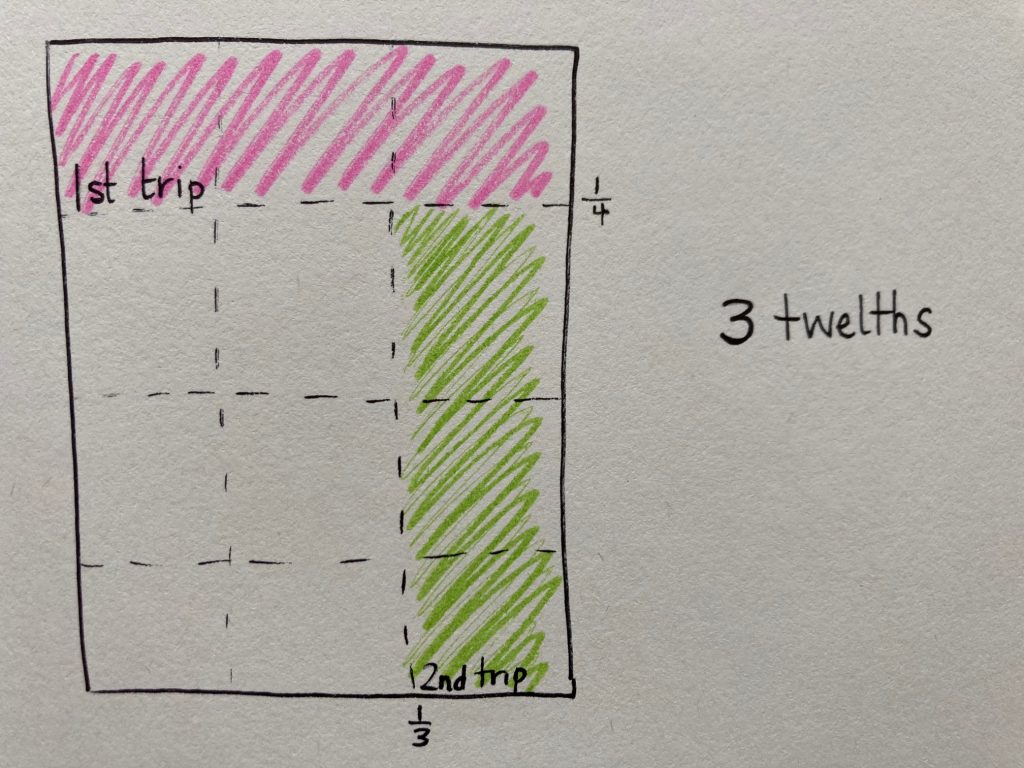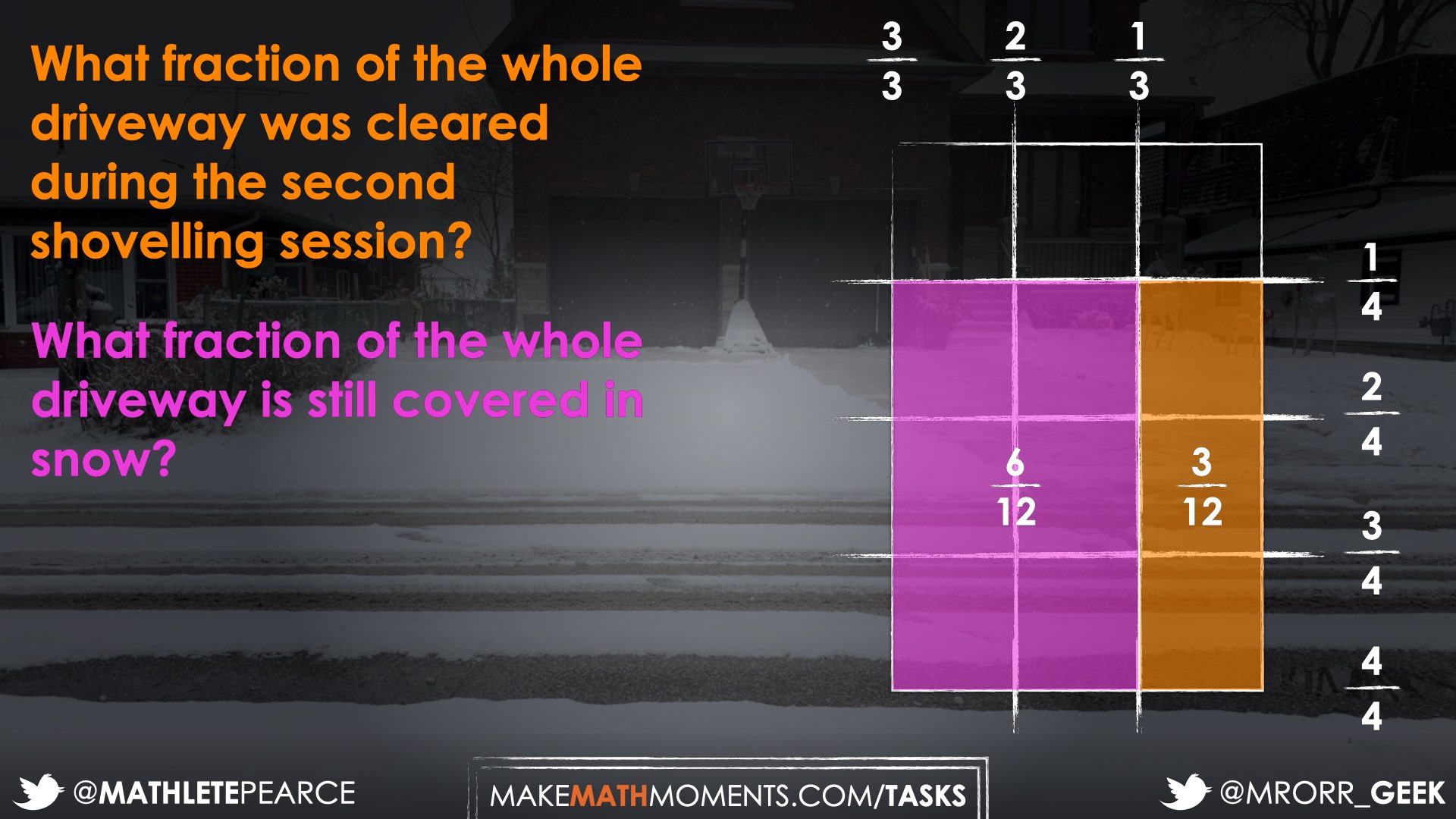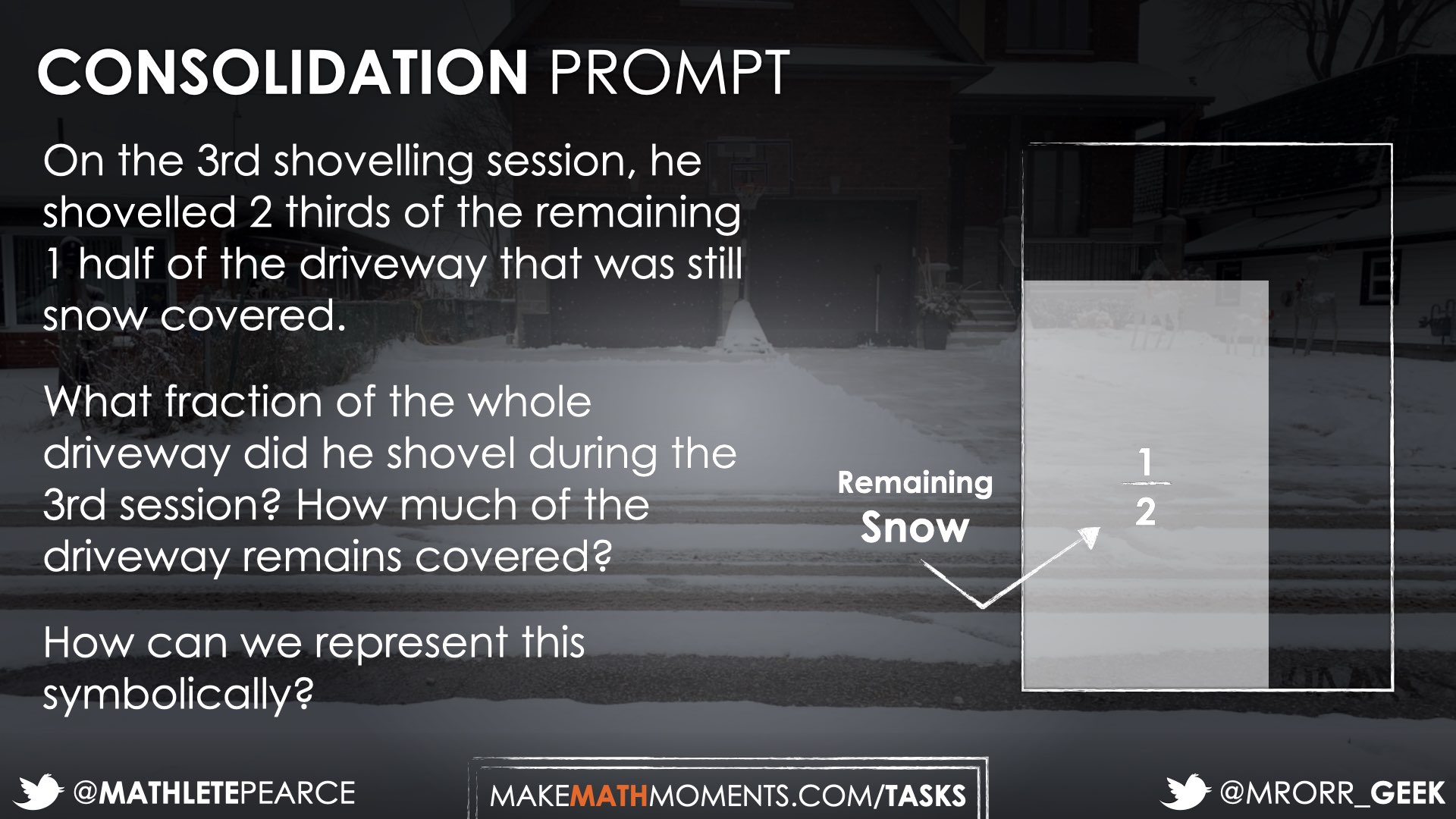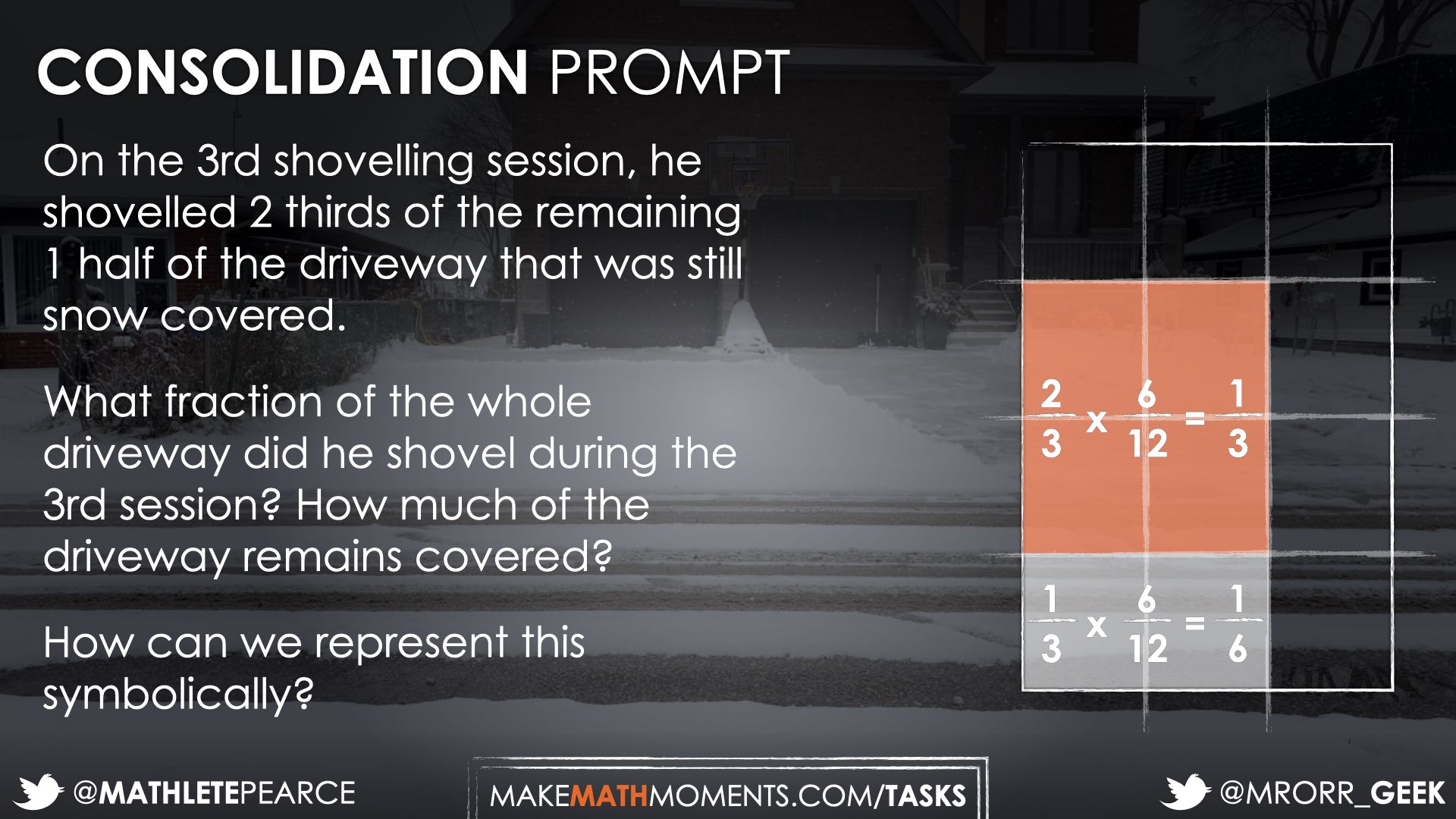SHOVELLING THE DRIVEWAY
MULTIPLYING FRACTIONS
Explore multiplying fractions conceptually using the area model to reason and prove.
Intentionality
Spark Curiosity
Fuel Sensemaking
During Moves
Student Approaches
Next Moves
Consolidation
Reflect and Consolidation Prompts
Resources & Downloads
Educator Discussion Area
Intentionality & Unit Overview
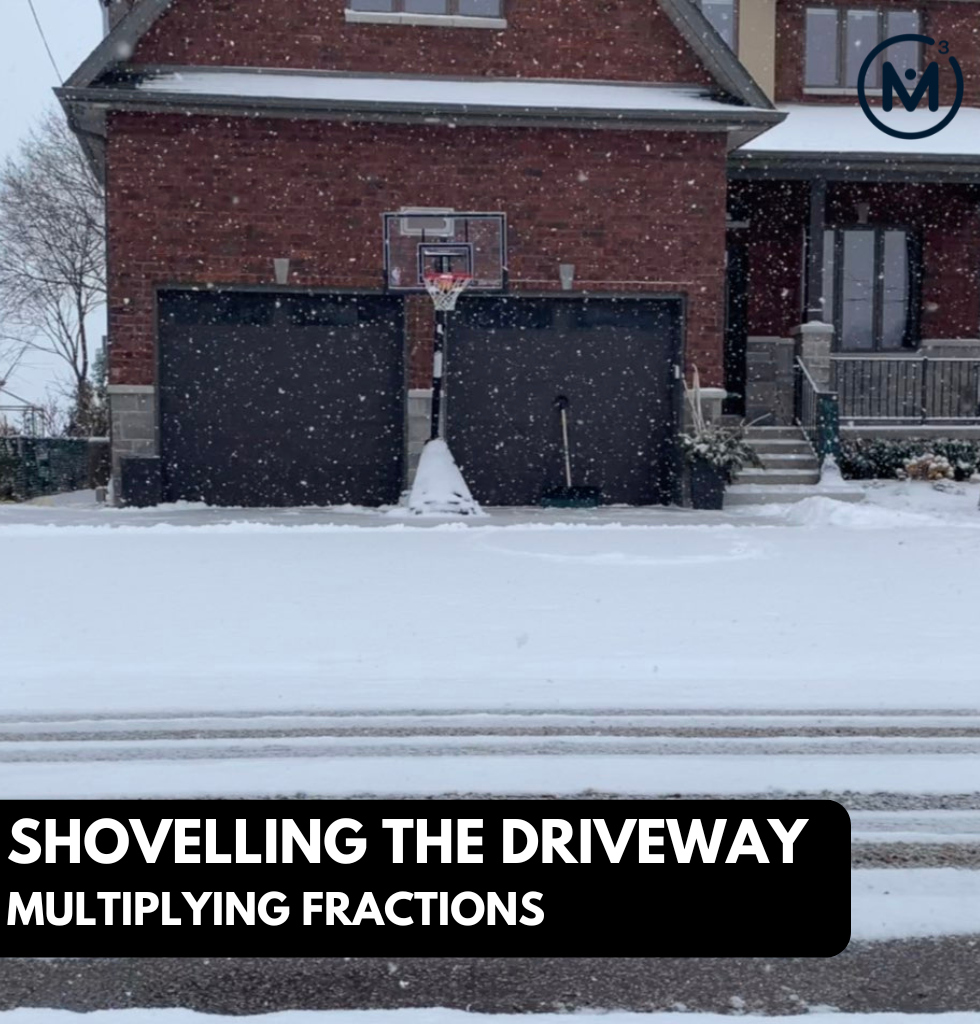
Length of Unit: 5 Days
Access each lesson from this unit using the navigation links below
Students will determine the fraction of the driveway that has been cleared, and the fraction of the driveway still covered in snow.
In this task, students will observe a driveway being cleared of snow using a shovel. The shoveller will clear sections of the driveway and then retreat to his home to warm up, leaving a snow covered fraction of the driveway each time until the task is complete. Students will be asked to determine how much of the driveway has been cleared, and how much remains covered in snow.
Some of the big ideas that will likely emerge in this task include:
- Multiplication can be interpreted as “groups of” or “parts of”, where the first factor is the number of groups, and the second factor is the quota.
- Multiplication can be represented using an array or area model.
- A part of a whole unit can be expressed as a fraction.
- A fraction described the number of parts relative to a whole.
- The fractional unit (the denominator) communicates how the whole is partitioned (number of parts).
- Equivalent values can be represented by different fractional notation (for example, \(\frac{1}{4}\) is equal to \(\frac{3}{12}\))
Spark Curiosity
What Do You Notice? What Do You Wonder?
Show students the following video:
Then, ask students:
What do you notice?
What do you wonder?
Give students 60 seconds (or more) to do a rapid write on a piece of paper.
Replaying the video and/or leaving a screenshot from the video up can be helpful here.
Then, ask students to share with their neighbours for another 60 seconds.
Finally, allow students to share with the entire group. Be sure to write down these noticings and wonderings on the blackboard/whiteboard, chart paper, or some other means to ensure students know that their voice is acknowledged and appreciated.
Some of the noticing and wondering that may come up includes:
- I notice a house.
- I wonder where it is.
- I wonder who lives there.
- I notice snow on the driveway.
- I wonder how much snow that is.
- I notice the person has a shovel.
- I notice he shovels a part of the driveway.
- I wonder how long that took, is the video real time?
- I wonder how much of the driveway he has left.
- I wonder how long it will take him.
At this point, you can answer any wonders that you can cross off the list right away. For example:
- This is a driveway in Belle River, Ontario.
- The video was filmed on Saturday January 23rd, 2021.
- Snow started early in the morning and the forecast predicted about 3 cm of accumulation.
- The man who is shovelling is named Kyle.
Estimation: Prompt
After we have heard students and demonstrated that we value their voice, we can land on the first question we will challenge them with:
How much of the driveway did he shovel? How much is left?
We can now ask students to make an estimate (not a guess) as we want them to be as strategic as they can possibly be. This will force them to determine a fraction of the driveway that would be reasonable before determining a more precise answer. Consider asking students to think about an estimate that would be “too low” and an estimate that would be “too high” before asking for their best estimate in order to help them come up with a more reasonable estimate.
It can be helpful to encourage students to draw a model of their thinking by creating a rectangle and partitioning the driveway to show the fraction of the driveway that was shovelled and the fraction of the driveway that remains covered in snow.
Encourage students to share their estimates, however avoid sharing their justification just yet. We do not want to rob other students of their thinking.
Facilitator Note:
The prompt intentionally omitted the word “fraction”. You might hear students describing the amount of driveway using fractional language, decimal language or standard units of measure. All descriptions of the amount are welcome. This might be a great opportunity to discuss equivalence.
Estimation: Partial Reveal & Update
Show students the following video:
You might consider having students estimate what fraction of the remaining snow was cleared in this second snow shovelling session and what fraction of the remaining snow remains.
After students share their estimates, you can reveal to them that one third of the remaining snow covered portion of the driveway was cleared in the second session and prompt them with this:
One third of the remaining snow covered portion of the driveway was cleared during the second snow shovelling session.
Based on your estimate of how much snow was cleared during the first shovelling session and knowing that one third of the remaining snow covered portion of the driveway was cleared during the second shovelling session…
What fraction of the whole driveway was cleared during the second shovelling session?
What fraction of the whole driveway is still covered in snow?
Give students some time to use their area models they have drawn to estimate the fraction of the driveway that was cleared during the first snow shovelling session and now partition the remaining snow covered portion of the driveway to represent removing one third of the remaining snow.
You might consider having students share their reasoning here through a mini-consolidation that is built off of student work samples that you carefully select and sequence.
Fuel Sense-making
Crafting A Productive Struggle:
Show students this short silent animation clip to reveal how much snow was cleared during the first session and how much snow was revealed during the second session:
Then, reiterate some of what was shared in the video by stating a storyline similar to the following.
Prompt students by stating:
One fourth of the driveway was cleared during the first shovelling session and one third of the remaining snow covered portion of the driveway was cleared during the second snow shovelling session.
What fraction of the whole driveway was cleared during the second shovelling session?
What fraction of the whole driveway is still covered in snow?
Facilitator Note:
Clarify, if needed, that you want students to determine the amount cleared in the second trip only (not the cumulative amount from both the first and second video). Be sure to remind students that they are not to use a calculator to determine the fraction of the driveway cleared during the second trip.
During Moves
While Students Are Productively Struggling….
Monitor student thinking by circulating around the room and listening to the mathematical discourse. Select and sequence some of the student solution strategies and ask a student from the selected groups to share with the class from:
- most accessible to least accessible solution strategies and representations;
- most common/frequent to least common/frequent strategies and representations; or,
- choose another approach to selecting and sequencing student work.
The tools and representations you might see students using to convince their peers and/or the teacher include:
- Paper folding.
- Using an area model
- Using a bar model
- Using equivalence
- Using common denominators
- Using a symbolic representation.
Have students share their strategies and reasoning for how to determine the fraction of the driveway cleared in the second video. Ask them to convince you and their peers that their answer is correct by sharing mathematical models.
Discuss their strategies and elicit student thinking during your consolidation to build off of their current prior knowledge and understanding rather than “fixing” or “funnelling” student thinking to a strategy and/or model that does not connect to their strategy and/or approach.
Student Approaches
Student Approach #1: Paper Folding
I used paper folding. First I folded the paper into four parts, because in the first video, he shovelled one-fourth. I coloured that in to show the three-fourths that were left. The second time he came out, he shoveled one-third of the snow that was left, so I folded the paper into thirds the other way. I could see that the driveway was made up of twelve equal parts. In his second trip, he shoveled three of the twelve parts, or three-twelfths. There are six-twelfths still covered in snow.
Student Approach #2: Area Model
I drew the driveway and started by cutting in into fourths, because on the first trip, he shoveled one fourth. I noticed on the second trip, he shovelled one third of the remaining snow, but he actually shovelled the other way. So I cut the driveway into three parts the long way (vertically). I could see that he had shovelled three-twelfths of the driveway on his second trip. He still has to shovel six-twelfths.
Student Approach #3: Area Model with Equivalence
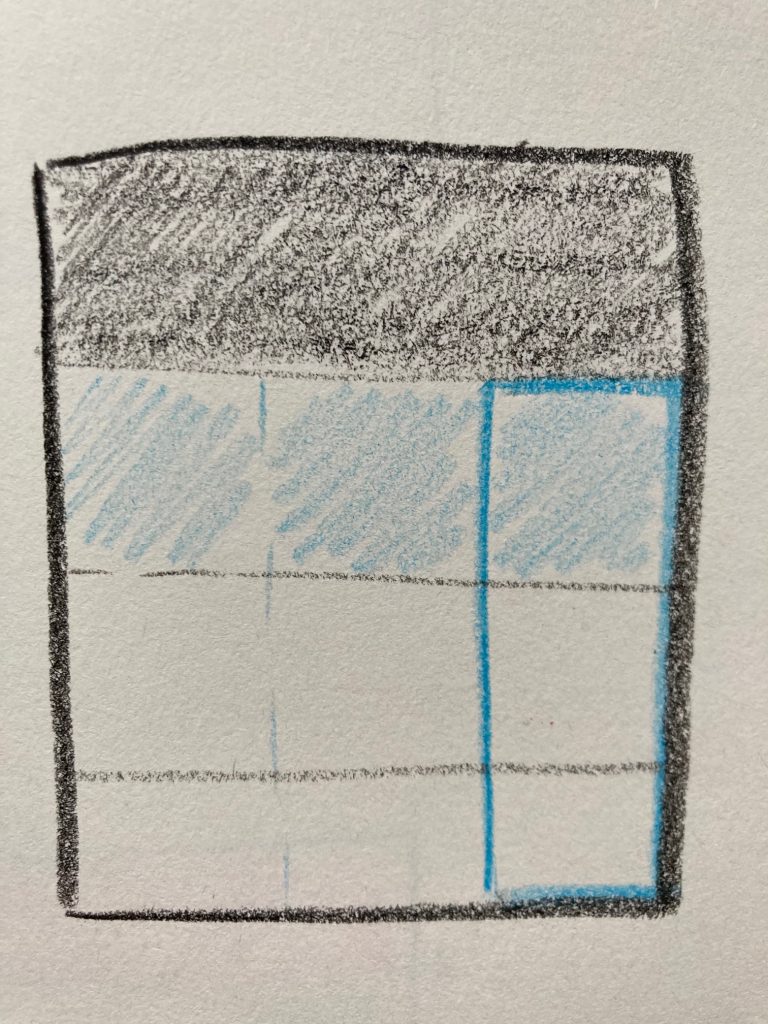
I partitioned the rectangle into four equal parts. I coloured the section that was already shoveled in black. The second time he came out, he shoveled one-third of the remaining three-fourths. I quickly realized that I had three parts already drawn on my rectangle. If he shovelled one third of those parts, he shovelled one of the three remaining parts. I was surprised to discover that he actually shovelled the same amount each time, one-fourth of the driveway. He still has to shovel half of the driveway.
Next Moves
Consolidation
Leverage a few student models to consolidate this task. Consider sequencing them from most accessible to least accessible.
Ultimately, we have designed these prompts to allow students to bump into multiplication of fractions using the area model. By partitioning a whole driveway into fourths, then partitioning into thirds, we can use the area model to visualize that the driveway has been partitioned into twelfths and counting how many twelfths were shovelled in the second session as well as how many twelfths of the driveway is still covered in snow becomes more natural.
Here’s a screenshot highlighting the driveway partitioned into fourths horizontally, then thirds vertically to reveal twelve equal parts:
Help students realize that he actually shovelled the same fraction of the driveway in the first and second video by asking purposeful questions. The following silent solution video may be helpful for students to “see” the equivalence by moving the parts and showing they “fit”:
After you have had an opportunity to make connections between some of the student solutions and the equivalence, land on the following question:
What operation was used to determine the fraction of the driveway shovelled on the second trip?
How could we represent this context as an equation?
Although students tackled this task through reasoning and visual representations, now is your opportunity to explain the context using mathematical language.
\(\frac{1}{3} \times \frac{3}{4} = \frac{3}{12} (or \frac{1}{4} \))
In today’s context we can articulate the mathematical situation as finding one third of one-fourth. Or one-third part/group of the three-fourths of the driveway still covered in snow.
You can view this silent solution video to help you plan how you can select, sequence and connect student representations to reveal this multiplication of fractions.
Reflect and Consolidation Prompts
Provide students an opportunity to reflect on their learning by offering these consolidation prompts to be completed independently.
Consolidation Prompt #1:
Show the following clip and verbally explain what is happening in the video to set them up for your consolidation prompt.
Explain the Consolidation Prompt Video with a script similar to this one:
As we know, 6 twelfths of the driveway (or one half) was still covered in snow.
During the 3rd shovelling session, 2 thirds of the remaining snow covered portion of the driveway was cleared.
What fraction of the driveway was cleared during the third shovelling session? What fraction of the driveway remains covered in snow?
Write an equation to represent the fraction of the driveway shovelled on the third trip.
As an additional opportunity for students to reflect, you could ask them this second Consolidation Prompt.
When students are finished solving the first prompt, you can share the following reveal video. Note that this might be the next day if you used the consolidation prompt as a ticket out the door to check for understanding.
Here is a screenshot of the final frame:
Consolidation Prompt #2:
What did you notice about all three trips to the driveway?
How was the amount of snow shovelled the same?
How was it different?
We suggest collecting this reflection as an additional opportunity to engage in the formative assessment process to inform next steps for individual students as well as how the whole class will proceed.
Resources & Downloads
Printable Lesson Plan PDF
Videos, Images & Media Files
Apple Keynote Presentation
Powerpoint Presentation
Printable Consolidation Prompts
Educator Discussion Area
Login/Join to access the entire Teacher Guide, downloadable slide decks and printable handouts for this lesson and all problem based units.
Explore Our 60+ Problem Based Units
This Make Math Moments Lesson was designed to spark curiosity for a multi-day unit of study with built in purposeful practice, number talks and extensions to elicit and emerge strategies and mathematical models.
Dig into our other units of study and view by concept continuum, grade or topic!


